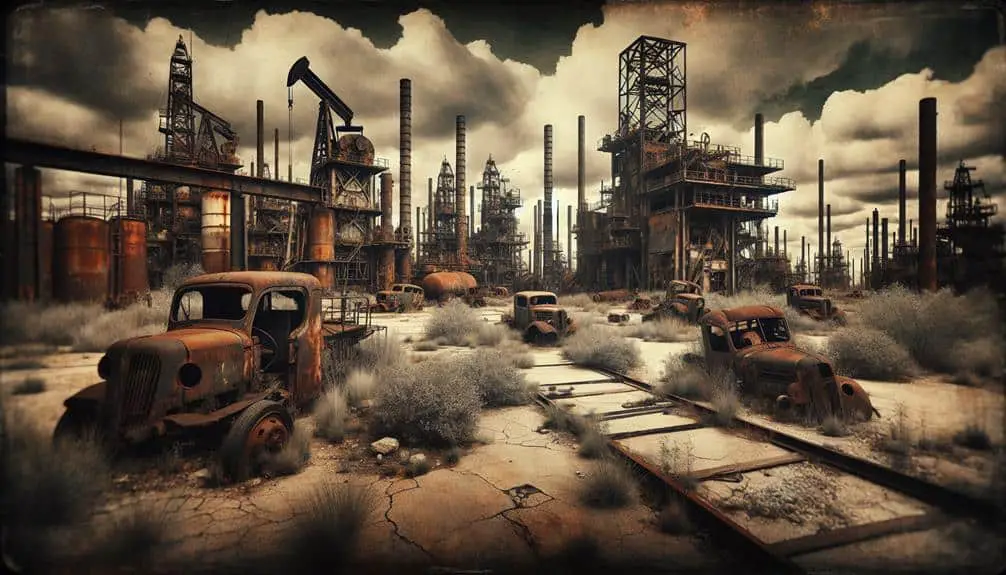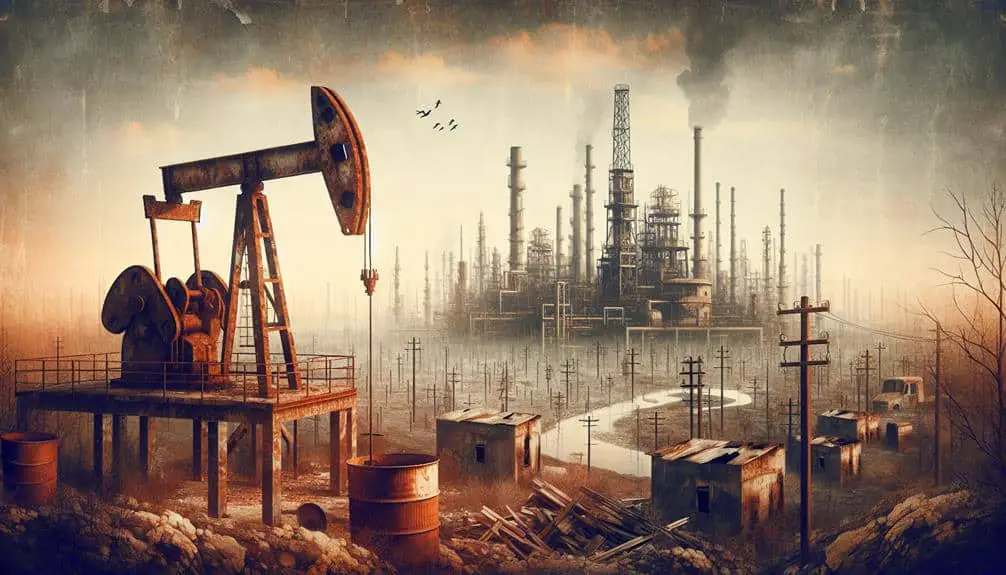Discover the intricate past of forgotten oil towns, revealing the cycles of boom and bust that hid deeper instabilities. Infrastructure struggled to keep pace with surging populations, leading to challenges in housing and services. Environmental degradation, social tensions, and economic downturns played pivotal roles in the rise and fall of these towns. Uncover the reasons behind their abandonment, from pollution to economic vulnerability. Preservation efforts now focus on remediation, rehabilitation, and diversification for a sustainable future. Expose the enthralling narrative of these towns, where prosperity, decline, and resilience intertwine to shape their enigmatic legacy.
Key Points
- Abandoned oil towns faced environmental degradation from extraction activities.
- Social issues like crime, substance abuse, and inadequate services contributed to abandonment.
- Unstable populations due to transient nature of work in the oil industry led to desertion.
- Economic vulnerability from fluctuating oil prices and industry changes caused abandonment.
- Environmental degradation, social challenges, and economic instability led to abandonment.
Early Boom and Bust Cycles
During the early boom and bust cycles of abandoned oil towns, rapid growth often masked the underlying instability that would eventually lead to their decline. The population influx driven by the promise of prosperity created immediate challenges for the infrastructure of these towns. As people flocked to these areas seeking employment and a better life, the demand for housing, utilities, and services quickly outpaced the capacity of the existing infrastructure, leading to strains on resources and systems.
The environmental consequences of this rapid growth were significant. The unchecked expansion of these towns often resulted in environmental degradation, such as pollution from oil extraction and waste disposal. The social implications were equally profound, with communities struggling to cope with the influx of diverse populations and the accompanying social tensions.
These early boom and bust cycles serve as a cautionary tale, highlighting the importance of sustainable development and careful planning to avoid repeating the mistakes of the past.
Rise of Industrial Oil Towns
The rapid industrialization of the early boom and bust oil towns laid the groundwork for the rise of industrial oil towns characterized by heightened production demands and infrastructural advancements. During the industrial revolution, the demand for oil soared, leading to the establishment of more specialized and larger oil towns. These industrial oil towns attracted a significant wave of urban migration as people sought employment opportunities in the booming oil industry.
With the increase in production demands, industrial oil towns saw the development of more sophisticated infrastructure to support extraction, refining, and distribution processes. Companies invested in modern technologies and transportation networks to streamline operations and meet the growing market needs efficiently. This era marked a shift towards more organized and structured oil towns, fostering a sense of community among workers and residents.
The rise of industrial oil towns not only transformed the landscape but also influenced social dynamics and economic growth in regions rich in oil resources. Urban migration continued to shape these towns, creating diverse and vibrant communities centered around the oil industry's prosperity.
Impact of Economic Downturns
How do economic downturns impact the stability and sustainability of industrial oil towns?
Economic downturns can have profound effects on these communities. When oil prices plummet, leading to a downturn, unemployment rates in industrial oil towns tend to soar. The reliance of these towns on the oil industry often means that a slump can result in mass layoffs, causing significant economic strain and uncertainty for residents. This not only impacts individuals and families but also has wider community effects.
Moreover, economic downturns can lead to environmental repercussions in oil towns. As budgets tighten, environmental protection measures may be compromised, potentially resulting in pollution and ecological damage. However, amidst these challenges, recovery efforts are essential. Communities can come together to explore diversification strategies, invest in retraining programs for displaced workers, and focus on sustainable practices to mitigate environmental impact.
Understanding the impact of economic downturns on industrial oil towns is vital for devising resilient strategies that can help these communities weather financial storms and emerge stronger in the face of adversity.
Abandonment and Desertion Reasons
Amidst the eerie silence of abandoned oil towns, the reasons behind their desertion reveal a complex interplay of economic, environmental, and social factors. The environmental consequences of oil extraction often lead to pollution and habitat destruction, making these towns unsustainable in the long run. Contamination of water sources, air pollution, and soil degradation contribute to the inhospitable conditions that force residents to leave.
Moreover, the social implications of living in oil towns can be profound. These communities often face social issues such as crime, substance abuse, and inadequate access to healthcare and education. The transient nature of work in the oil industry can lead to unstable populations, making it challenging to establish a sense of community and belonging. Additionally, when oil prices plummet or industries shift, these towns are left economically vulnerable, resulting in job losses and a dwindling population.
In essence, the abandonment of oil towns is a culmination of environmental degradation, social challenges, and economic instability, painting a cautionary tale of the consequences of unsustainable resource exploitation.
Preservation Efforts and Future Prospects
Efforts to preserve and revitalize abandoned oil towns require a multifaceted approach that addresses environmental remediation, social rehabilitation, and economic diversification. Preservation challenges in these towns often stem from the legacy of pollution left behind by the oil industry, making environmental cleanup a critical first step towards revitalization.
Community revitalization efforts should prioritize engaging with local residents to make sure their needs and concerns are heard and integrated into the redevelopment plans. Social rehabilitation programs can help address the impacts of economic downturns and population decline, fostering a sense of belonging and pride among residents.
Economic diversification is key to ensuring the long-term sustainability of abandoned oil towns. By attracting new industries, promoting tourism, or investing in renewable energy projects, these towns can create new opportunities for growth and prosperity. Collaboration between government agencies, non-profit organizations, and private investors is essential to driving forward these revitalization efforts. With a strategic and inclusive approach, abandoned oil towns have the potential to transform into thriving communities once again.
Frequently Asked Questions
What Were the Social Dynamics Like in These Oil Towns During Their Early Boom and Bust Cycles?
In those oil towns, community dynamics were intense during boom times, with economic impacts shaping social structures. Cultural changes were rapid, reflecting the transient nature of the industry. The rise and fall of these towns left lasting imprints.
How Did the Rise of Industrial Oil Towns Impact the Surrounding Environment and Wildlife?
As industrial oil towns rose, the environmental impact was profound. Wildlife displacement occurred as habitats were destroyed for development. The once-thriving ecosystems faced devastation, forever altered by the encroaching human presence. Nature suffered.
What Were Some of the Long-Term Effects on Local Economies Following Economic Downturns in These Oil Towns?
When economic downturns hit oil towns, the local economies suffered greatly. Infrastructure deteriorated, leading to population migration. However, through resilience, communities can bounce back. Economic recovery efforts are essential for revitalizing these areas.
Were There Any Unique or Unexpected Reasons for the Abandonment and Desertion of These Oil Towns?
You never expected what led to the abandonment of oil towns. Cultural significance faded as urban exploration revealed eerie landscapes. Economic factors dried up opportunities, leaving towns desolate. Environmental impact lingered, a haunting reminder of prosperity lost.
What Challenges Are Faced in Preserving the History and Heritage of These Abandoned Oil Towns, and What Are the Future Prospects for Their Preservation Efforts?
Preserving the history of abandoned oil towns poses challenges due to neglect, natural decay, and lack of funding. Sustaining preservation efforts requires community involvement, historical awareness, and creative solutions. The future prospects depend on collective commitment.



